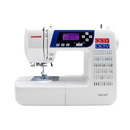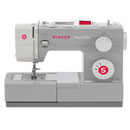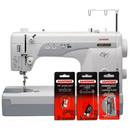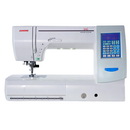If sorting out the best storage solution for your pattern collection has been at the top of your to-do list recently, you’ve probably noticed it isn’t easy. You’re faced with a couple of questions. What to store the patterns in and how to file them.
The best storage solutions for your pattern collection need to be sturdy, durable and long lasting. Clear plastic totes make ideal storage boxes as the contents can be seen at a glance. Each pattern should be kept in an acid free plastic cover within the box to protect the tissue paper and envelope. Patterns can be stored by era or style.
If you’re like me, you’ve probably collected quite a few sewing patterns over the years. From projects you’ve made to patterns you might make in the future. In my case, I even buy patterns for the artwork on the front.
I have boxes full of patterns dating from the 1940s to the current day, all crammed in together. Which isn’t good for them and doesn’t help me find what I’m looking for. To get organized I need to set up a system that categorizes the patterns simply and effectively.
Why Store Sewing Patterns?
Sewing patterns are made from tissue paper and are
sold in paper envelopes. Both are susceptible to damage. They can get
creased, crumpled and even torn. Moisture and air are particularly
bothersome as they discolor the paper over time.
Sewing patterns can be expensive, especially if you buy them new. Some vintage patterns are also going up in price depending on how rare they are, or how sought after. This means replacing a damaged pattern can be a costly endeavor. It could also be impossible.
Storing sewing patterns safely away from dust and moisture ensures their longevity. For a pattern collector, the longer a pattern can be kept pristine, the better the return on an investment. Fashion historians love old sewing patterns as they can be used as evidence for sewing techniques and styles of the past. Keeping them free from damage saves them for future generations.
Obviously, this is more important with vintage or antique patterns. But, there’s nothing stopping today’s patterns becoming the vintage of tomorrow.
How to Store Vintage Patterns?
Vintage patterns need extra care and attention. Their age makes them more susceptible to damage from air, dampness and even storage.
The best way to protect the patterns is by using acid free sleeves. These sleeves will protect the pattern envelope and tissue from dust and damp. It will also reduce the telltale signs of aging, the yellow or brown stains caused by years of exposure to the air.
Even modern patterns can benefit from acid free sleeves. Taking steps to protect your patterns from the get-go will preserve them for years to come.
How to Store Patterns from Different Eras?
The best solution for me is to store by era. That means I need a box or two for each decade or so from the 1940s onwards. As I only have two patterns from the 50s, I’ll include them with the 40s box. The 60s can go in with the 70s and 80s. Then everything from the 90s onwards can go in the next box.
I have quite a few toy and doll clothes patterns I want to keep separate, so they get a box of their own, regardless of era.
How to Store Different Styles of Patterns
Next, the patterns within each box will be sorted into style. Skirts, dresses, and pants will each be filed behind dividers. This will help me find a skirt pattern from the 70s out of a box full of random patterns.
The storage solutions in this article should help you organize your patterns in a way that works for you.
Here’s a list of items I’m planning on using and links to where you can find them:
Golden State Art, Pack of 50 Acid-Free Crystal Clear Sleeves Storage Bags for Framing Mats Mattes (8 3/8 x 10 1/8 inches)
These plastic sleeves are acid free and ideal for long term storage of paper items. Available in two sizes, the smaller size can fit the average sized pattern.
Patterns can become discolored over time and these bags help prevent that. They also stop the envelopes tearing or crumpling when stored with other patterns. Especially the little flaps at the top of the envelopes.
Storing your sewing patterns in a separate acid free sleeve will keep them pristine and free from harm.
Key Features
-
Acid free
-
Re-sealable adhesive strip
-
Transparent
Pros
-
Re-sealable adhesive strip is below the sleeve opening
-
Easy to use
Cons
-
One size may not fit all patterns
IRIS USA TB-17 19 Quart Stack & Pull Box, Multi-Purpose Storage Bin, 6 Pack, Pearl
When it comes to storing precious patterns, you need something durable, waterproof and stackable.
This 6 pack of storage boxes from Iris USA are an ideal solution.
Made from sturdy plastic with secure buckle latches, these totes ensure safe containment and portability of your sewing patterns. A little over 12 inches, there is ample headroom for both standard sized pattern envelopes and the slightly larger ones.
Offering protection from both dust and dampness, the clear plastic sides on these totes enable you to see your patterns at a glance.
Key Features
-
Transparent sides for easy viewing of contents
-
Sturdy plastic
-
Stackable
-
Portable
-
Come in a pack of 6
Pros
-
Can be stacked in smaller areas to save space
-
Secure buckle up latches
-
Can be used anywhere
Cons
-
May not fit extra tall patterns
Sterilite 16448012 16 Quart/15 Liter Storage Box, White Lid with Clear Base, 12-Pack
Easily portable, with a height of just over 11 inches, these totes can accommodate standard sized patterns.
Key Features
-
Ideal for a range of storage needs
-
Lid snaps on firmly, enabling easy lifting
-
Transparent giving clear visibility to contents
-
Indented lids allow easy stacking
-
Available as a pack of 12 totes
Pros
-
Compact and stackable
-
Sturdy, snap on lid
-
Easy to see contents
Cons
-
Some larger patterns may not fit
Sterilite 19849806 18 Quart/17 Liter Ultra Latch Box, Clear with a White Lid and Black Latches, 6-Pack
These clear plastic totes are available in a pack of 6. Each one has a strong latch ensuring the lids stay on. Contents are kept secure and free from dust and moisture damage.
The transparent sides offer instant visibility for contents. A height of 12.25 inches can accommodate standard sized patterns with ease.
Key Features
-
Sturdy lid with heavy duty latches
-
Portable
-
Stackable
-
Long term storage solution
-
Available as a pack of 6
Pros
-
Transparent sides for great visibility
-
Strong latches ensure lids stay on
Cons
-
Bigger patterns may not fit
(30) 7" Record Divider Cards - White, Standard 20mil - 7" x 8 1/2" - #07NS85WH20
A great way to separate skirt patterns from pant patterns is with divider cards. These cards will help you sort your sewing patterns by style, brand or even vintage.
Easy to mark with either a printed label or marker pen, these cards are durable with rounded edges, preventing damage to you and your patterns!
This pack contains 30 divider cards giving plenty of opportunity to sort your sewing patterns in any way that works for you.
Key features
-
Pack of 30
-
Reusable
-
Can be used with labels or marker pen
-
Durable with rounded corners
Pros
-
Durable construction
-
Rounded corners to prevent jabbing
Cons
-
A little expensive
Conclusion
The storage solutions and ideas in this article are a great way to keep your sewing patterns safe and secure. Let me know in the comments how you store your patterns. Do you use a similar system? Has this article given you pointers on the best storage solution for your pattern collection?
For more sewing hints, tips and sewing chat, check out my YouTube channel
If you’re interested in
collecting patterns, I have a video on How To Tell If your Vintage Sewing Pattern is Factory Folded. The video explains why factory folded patterns are the best type to get for collectors.
This article contains Amazon and other third party associate links. I may earn a referral fee for any purchases made via these links. This does not cost you any extra, and there’s no obligation to use the links. Although, they do help support me and this blog.
The items showcased may be available from other suppliers if you prefer not to use the links.
- Janome 3160QOV Sewing Machine

- Price: $599.00
- Juki TL-2020PE Limited Platinum Edition Sewing Machine

- Price: $1599.00















Comments
Post a Comment